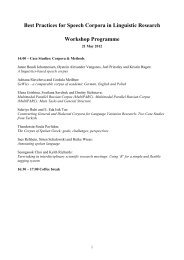96 • 2011 - Hamburger Zentrum für Sprachkorpora - Universität ...
96 • 2011 - Hamburger Zentrum für Sprachkorpora - Universität ...
96 • 2011 - Hamburger Zentrum für Sprachkorpora - Universität ...
You also want an ePaper? Increase the reach of your titles
YUMPU automatically turns print PDFs into web optimized ePapers that Google loves.
variant spellings can then be used for improved<br />
retrieval, for generating multilingual social networks,<br />
and more.<br />
4) News bias – regarding the choice of facts as well as<br />
the expression of opinions – will be reduced by<br />
looking at the media coming from different countries.<br />
News bias becomes visually evident when looking at<br />
automatically generated social networks (see, e.g.<br />
Pouliquen et al., 2007, and Tanev, 2007). For instance,<br />
mentions of national politicians are usually preferred<br />
in national news, resulting in an inflated view of the<br />
importance of one’s own political leaders.<br />
From the point of view of an organisation with a close<br />
relationship to many international users, there is thus no<br />
doubt that highly multilingual text mining applications<br />
are necessary and useful.<br />
3. Ways to harness the benefits<br />
of multilinguality<br />
Extracting information from multilingual media reports<br />
and merging the information into a single view is<br />
possible, but developing text mining tools for each of the<br />
languages costs effort and is time-consuming. However,<br />
there are various ways to limit the effort per language (for<br />
an overview of documented methods, see Steinberger,<br />
forthcoming). Some monitoring and automatic alerting<br />
functionality can even be achieved with relatively simple<br />
means. This section summarises the main multilingual<br />
media monitoring functionality provided by the EMM<br />
family of applications.<br />
3.1. Multilingual category alerting<br />
EMM categorises all incoming news items into over<br />
Figure 2. Visual alerting of country-category<br />
combinations for all Public-Health-related categories.<br />
The alert level decreases from left to right.<br />
Multilingual Resources and Multilingual Applications - Invited Talks<br />
Figure 3. English news cluster with 26 articles and<br />
automatically generated links pointing to equivalent<br />
news in the other 19 NewsExplorer languages.<br />
1,000 categories, using mostly Boolean combinations or<br />
weighted lists of search words and regular expressions.<br />
As the categories are the same across all languages,<br />
simple statistics can show differences of reporting across<br />
languages and countries and highlight any bias (see<br />
Figure 1 for some examples). Even automatic alerting<br />
about imported events reported in any of the languages is<br />
possible: EMM keeps two-week averages for the number<br />
of articles falling into any country-category combination<br />
(e.g. POLAND-TUBERCULOSIS) so that a higher influx of<br />
articles in only one of these combinations can trigger an<br />
alert even if the overall number of articles about this<br />
category has hardly changed. That way, users are visually<br />
alerted of the sudden increase of articles in that<br />
combination even for languages they cannot read (see<br />
Figure 2). Once aware, they can translate the articles or<br />
search for the cause of the news spike via their<br />
professional contacts. This functionality is much used<br />
and appreciated by centres for disease prevention and<br />
control around the world.<br />
3.2. Linking of related news across languages<br />
Every 24hours, EMM-NewsExplorer clusters the related<br />
news of the day, separately for each of the 20 languages it<br />
covers, and then links the news clusters to the equivalent<br />
clusters in the other languages (see Figure 3). Following<br />
the links allows users – for any news cluster of choice –<br />
to investigate how, and how intensely, the same event is<br />
reported in the different languages. For each news cluster,<br />
the number of articles – and meta-information such as<br />
entity names found (and more) – are displayed. Links to<br />
Google Translate allow the users to get a rough<br />
translation so that they can judge the relevancy of the<br />
articles and get an idea of what actually happened.<br />
27



